Tuesday evening in Chicago, Warren blanked the Brew Crew for two innings, allowing nary a baserunner and striking out three. Normally, this wouldn’t be remarkable. But, for the 2016 Cubs, it was a minor milestone: Warren was the first Cubs reliever to throw two innings in an appearance. As the starters have gone deep into games and paced the league in key categories, the ‘pen has had few opportunities to shine, but Warren has stood out nonetheless. In eight innings this season, he’s struck out nine, walked three, allowed two hits, and generally confounded hitters with his impressive mix of pitches, unique for a reliever. Oh, and he hasn’t allowed a run.
Many anticipated that Warren would be a key to the Cubs’ success this season, including us here at BP Wrigleyville. But it’s worth asking, how has Warren done it? And can he continue to elude hitters’ bats, or will he fizzle out in a relief role over a whole season?
In his very successful eight innings of work, Warren has actually done something somewhat counterintuitive: he’s throwing his fastball more often. In the piece linked above, Ryan Davis explained that Warren’s best pitches are his slider and his changeup, and that his fastball is actually quite hittable, speculating therefore that a decrease in fastball usage would lead to greater effectiveness. This April, Warren has thrown 40 percent fastballs, whereas last season he sat in the mid-30s both as a starter and as a reliever. His fastball velocity is 93 miles per hour, right about where it was last season during his starting period, and actually a tick slower than in his months as a reliever. And according to Brooks Baseball, his release points on his pitches are more or less consistent with his 2015. So what gives?
Well, Warren has hardly thrown his curveball and sinker this season, allowing him to throw his slider and changeup more often—you know, the pitches on which he gets swings and misses. This is a function of his relief role; since he’s facing hitters only once in a game, he can cut back on showing his whole arsenal and focus on his best pitches. Clearly, he’s found success with sequencing those three pitches. In his eight innings this season, his fastball, slider, and change have garnered whiff rates of 13.5, 28, and 11.5 percent, respectively. For his fastball and change, those are significantly better than his career average.
All of this has resulted in a 30 percent strikeout rate, easily tops in his career. That’s an unsustainable rate—30 percent is the rate at which the league’s best pitchers strike out hitters—but, in a relief role for most of the season, Warren could rest comfortably between 20 and 25 percent. As that rate comes down, he’ll experience a concurrent rise in hits allowed, as his opponent BABIP is a minuscule .118 at present. Warren’s groundball rate is also significantly better than his career mark, closer to 60 percent than his 45 percent average. His slider and changeup are generating those grounders, and relying more on those offerings might produce more grounders overall, but we shouldn’t expect Warren to become an extreme groundball pitcher.
One factor of note beyond Warren’s control is the quality of his catchers. Miguel Montero and David Ross are two of the best framing catchers in the game, consistently stealing strikes for their pitchers. Montero replacement Tim Federowicz rated slightly negatively in 2015 at Triple-A. Warren’s two receivers last season, Brian McCann and John Ryan Murphy, both rated negatively in framing runs last season (McCann has been a good framer in his career, however). In such a small amount of innings, Warren hasn’t benefited much from having those two behind the dish for him, but as he racks up innings throughout the summer, those marginal gains will materialize.
Maddon placed a significant amount of confidence in Warren on Tuesday, trusting him to bridge the gap between Hendricks and the back end of the bullpen. It was a key tactical decision, as Hendricks was cruising through five innings, but on a cold Chicago night, with the wind blowing in, and Brewers ace Jimmy Nelson pitching well, the Cubs needed to scrape together a run in the bottom of the inning. Maddon pulled the strings, Tommy La Stella and Dexter Fowler executed at the plate and tied the game, and Warren kept the Brewers at bay for two innings. If he is to remain in relief, Warren’s fastball, slider, and changeup should all continue to stymie hitters, and he could fortify a quietly good Cubs bullpen into October.
Lead photo courtesy Matt Kartozian—USA Today Sports.
